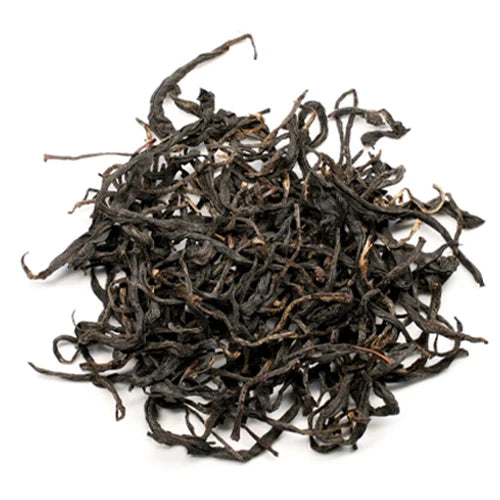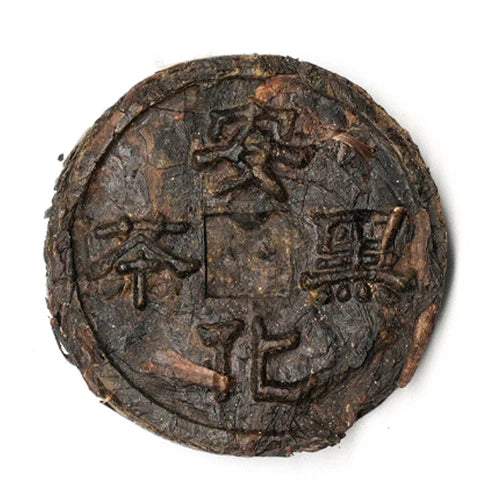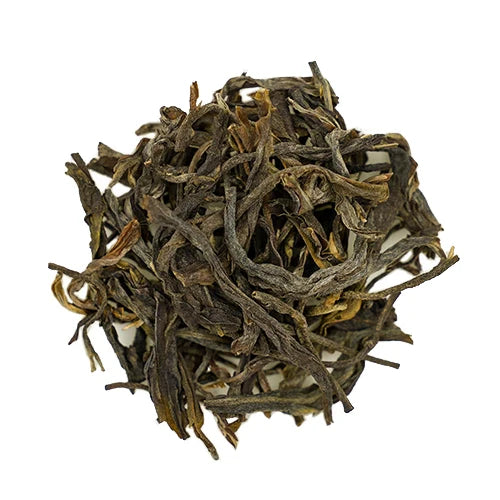I. Introduction
Oolong tea occupies a unique place between black and green teas. Its characteristics incorporate qualities of both fully oxidized black tea and lightly oxidized green tea, yet it remains distinct from either. Oolong tea's special processing technique involves partial oxidation, setting it apart from other tea varieties. However, many tea drinkers and aficionados still debate - is oolong tea more similar to black tea or green tea?
To discover the answer to this question, we must examine oolong tea's origins in China, explore its specialized production process, analyze its compounds and taste profile, compare it to black and green loose leaf teas, and investigate its health benefits. Only by looking at all these factors can we truly understand oolong tea's true nature and where it belongs among the different classifications of loose leaf tea. In this article, we will unveil oolong tea's identity by benchmarking it against black and green teas.

II. Oolong Tea: Origin and Production Process
Oolong tea originates from the Fujian province in China. Some scholars trace its earliest productions back to the Ming Dynasty in the 15th century, where it was known as "huangcha" or "yellow tea" due to its light color after oxidation. The most renowned varieties still hail from mountain regions of Fujian like Wu Yi Shan.
Partially oxidative fermentation is the special manufacturing technique that distinguishes oolong tea. Tea leaves that are still fresh are rolled, twisted, and wilted before being gradually oxidized to about 25–70%. Unlike this, loose leaf green tea only oxidizes by 1% to 2% in order to completely avoid fermentation. It is also not the same as black tea, which is fully fermented to an oxidation level of 75–99%.
Tea leaves are spread out in thin layers and allowed to wither, lowering their moisture content from 50–60% to 30–40% over the course of 12–24 hours. This promotes the best possible chemical reactions in the subsequent oxidation stage. After that, the leaves are rolled by hand or shaken in bamboo baskets to break down cell walls and promote enzymatic interactions.
Oxidation takes place in a well-ventilated environment over 5-10 hours. Producers skillfully control temperature, humidity and air flow to achieve the desired level of oxidation in the leaves. This imparts oolong tea's trademark color, aroma and taste. Finally, the leaves are fired to terminate oxidation. Top-grade oolongs may be individually fired.
III. Characteristics of Oolong Tea
Oolong tea has a distinct flavor profile that falls between that of green and black tea because of the partial oxidation that characterizes its production. Depending on the varietal and style, oolong tea's brewed leaf can have colors ranging from a light coppery orange to a deeper maroon. Typically, it has a flowery, fruity, honey-like, or grassy scent with faint roasted overtones. Connoisseurs seeking the best loose leaf tea often choose oolong varieties that uphold the highest quality standards for taste, aroma and processing.
Oolong teas have a flavor profile that is smooth and semisweet in the cup. While highly oxidized varieties take on more of a malty, toasty aspect, light styles are grassy and floral. Oolong tea's complexity stems from a harmony of roasted notes reminiscent of black tea and green tea characteristics. Its flavor is full without being overly sharp or harsh. Between green and black tea, the caffeine content is in the middle.
The key attribute separating oolong from other tea types is its oxidation level. At 25-70% oxidation, its leaves and liquor exhibit qualities of both unoxidized green tea and fully fermented black tea. This partial fermentation is what gives oolong tea its multifaceted yet balanced flavor.
IV. Comparing Oolong Tea with Black Tea
Oolong and black tea share some similarities due to both undergoing a controlled oxidation process. On a basic level, loose leaf oolong tea and black tea brewed leaves appear darker in color than green tea. Their liquor is also commonly described as richer and slightly stronger in flavor.
But there are differences when you look at how much oxidation is occurring. Black tea that has undergone complete fermentation reaches 75–99% oxidation, giving it a stronger, bolder flavor profile with pronounced hints of molasses, smoke, or cooked wood. The 25-70% oxidation of oolong tea results in a softer aftertaste with greener, floral notes that are still detectable amidst toasted notes.
Divergent production techniques are also used. Complete fermentation is applied to black tea, and then it is immediately dried. In order to avoid complete fermentation, oolong tea undergoes twisting, withering, and multiple oxidations. Oolongs with this prolonged treatment have more subtlety that can be attributed to partial oxidation alone.
V. Comparing Oolong Tea with Green Tea
On a foundational level, oolong and green tea share Chinese origins and minimal oxidation levels compared to black tea. Their brewed leaves both retain a yellow-green color. Certain oolong varieties like Pi Lo Chun can even approximate the light, vegetal flavors of green tea.
On the other hand, production and attributes differ significantly. Before drying, green tea is only slightly (1%–2%) oxidized to stop enzymatic browning. This keeps its pale coloring and green, vegetal flavors intact. Before being fired, oolong tea is subjected to a more thorough 25-70% oxidation through methods such as twisting and withering. This adds the toasty notes found in oolongs that are lacking in green tea.

Green teas have more of a crisp, grassy flavor, whereas oolong teas have a more floral, semi-oxidized flavor with hints of roasted malt. Green teas have the lowest amounts of caffeine because their minimal oxidation prevents the formation of caffeine. Because of partial oxidation, oolongs have less caffeine than loose leaf black tea but more than green tea.
VI. Health Benefits of Oolong Tea
Many perceived health benefits link oolong tea to its high polyphenol content, especially EGCG, the same antioxidant compound abundant in green tea. Some key areas of research on oolong tea include:
Weight management: Studies show oolong tea extract may increase fat oxidation and support weight loss through thermogenesis and fat absorption inhibition in the gut.
Heart health: Polyphenols in oolong tea may help reduce LDL "bad" cholesterol levels and increase HDL "good" cholesterol. One review linked regular oolong tea consumption to lower risks of cardiovascular disease.
Anti-cancer activity: Test tube and animal research suggests polyphenols in oolong tea induce cancer cell death and inhibit tumor growth through antioxidant and anti-inflammatory mechanisms. More human studies are still needed.
Diabetes protection: Compounds in oolong tea may improve insulin sensitivity, protect pancreatic cells and inhibit carbohydrate-hydrolyzing enzyme activity to support healthy blood sugar levels.
Bone health: Oolong tea contains minerals like manganese that promote bone formation. One study found oolong tea extract helped increase bone mineral density in rats.
However, more robust clinical trials are still warranted before making conclusive health claims. Variations in oolong tea selection type and steep time may also impact its bioavailability and degree of benefits.
VII. Comparing Popular Oolong Tea Varietals
Within the broad category of oolong tea, different regions and production methods have led to distinctive styles. Let's explore some top oolong varietals:
Tieguanyin: Considered the "Queen of Oolongs", this varietal originated in Taiwan but traces back to famous Mount Wuyi in Fujian. Medium oxidation lends sweet aromas of orchid, grain and honey. Its delicate floral flavors pair nicely with dim sum.
Da Hong Pao: One of China's "Four Great Oolongs" from Fujian, it has a rich, complex profile due to longer oxidation.
Jin Xuan: A lighter milk oolong style prized for its creamy mouthfeel and lingering sweet aftertaste. Hailing from Taiwan and China, it soft grassy and nutty flavors make it easy to enjoy anytime.
Baozhong: Known as "Pouchong", this Chinese varietal undergoes extensive oxidation for deeper copper coloration. Smokey overtones complement its malty, maple-like base. Great for iced tea too!
Pi Lo Chun: Revered as the "Green Snail Spring", it brightens one's spirit. This delicately green Taiwan oolong enchants with floral aromatics and smooth vegetal sip.
VIII. Brewing and Serving Oolong Tea
Proper brewing is crucial to fully unlocking an oolong tea's intricate flavor profile. While guidelines provide a starting point, some flexibility exists according to one's personal taste and the particular tea variety. Experimentation allows discerning subtle differences between cultivars and processing styles.
Using a gaiwan or yixing teapot specially suited for oolong tea immersing leaves in water aids controlling steep times down to the second. This permits adjusting oxidation levels extracted from each infusion. Two to three steeps often suffice before leaves diminish, though some premium whole leaf varieties grant four or more refreshing rounds showcasing their depth.
Playing with water temperature a few degrees above or below the general standard also impacts outcomes. Heated water reacting with leaf enzymes draws out diverse aspects - for example, lower heat preserving vegetal aspects while higher draws out additional roasted dimensions. Steeping shorter or longer than suggested timings produces own sets of effects as well.
Taking notes during these practice sessions helps identify favorite complexions. Recording details such as cultivar, leaf amount, water ratio, temperature, steep length and tasting observations builds a reference for consistently recreating preferred brews. This customized understanding brings tea appreciation to new pinnacles where one truly understands how processing intricacies manifest in each astonishing cup.
IX. iTeaworld's Early Black Friday Delights
Get ready to kick off your holiday shopping with iTeaworld's early Black Friday deals! With incredible discounts and enticing offers, there's no better time to indulge in the world of tea. Here are the top two deals you don't want to miss:
Best Gift: Tea Sampler
Looking for the perfect gift for the tea lover in your life? Look no further than iTeaworld's Tea Sampler deal. When you purchase any of the three designated products - the New Oolong Tea Sampler, Cold Brew Tea Selection, or Green Tea Selection - you'll receive another Tea Selection of your choice for free! Yes, you read that right - buy one, get one free. Simply apply the code "BF50" at checkout to avail of this fantastic offer. It's the ideal opportunity to explore a variety of teas or surprise a friend with a delightful tea gift set. Don't miss out on this chance to enhance your tea experience!
All Tea 20% OFF
Spread the warmth and joy of tea this holiday season with iTeaworld's exclusive 20% off deal. Use the code "BF20" at checkout to enjoy a 20% discount on all tea products including popular black friday tea selections. This is the perfect opportunity to stock up on your favorite teas or discover new ones. Whether you're looking for a comforting cup of black tea, a refreshing green tea, or a soothing herbal infusion, iTeaworld has you covered. With Christmas just around the corner, there's no better time to surprise your loved ones with the gift of tea. Delight them with unique flavors and aromas of black friday tea deals that will make their holiday season truly special.
Don't miss out on these amazing early Black Friday deals from iTeaworld. Treat yourself or your loved ones to the wonderful world of tea and elevate your tea-drinking experience. Hurry and take advantage of these limited-time offers before they're gone. Happy sipping and happy shopping!
X. Conclusion
In summarizing, oolong tea occupies a unique middle ground between green and black tea. Its origins trace to China where a specialized withering and oxidation process was developed to partially ferment the leaves. This imparts oolong teas their signature flavors balancing green tea selection vegetal notes with roasted complexity.
While oolong tea shares some attributes with green and black tea such as originating in China or undergoing oxidation, it stands distinct due to its intermediate oxidation level of 25-70%. This lends oolongs a diverse flavor profile sitting between lightly oxidized green tea and robust fully fermented black tea. Proper brewing techniques further bring out these defining characteristics.
Going forward, more human studies are still needed to validate oolong tea’s proposed health benefits. However, its polyphenol content indicates anti-obesity, cardioprotective, anti-cancer and other advantages. Ultimately, oolong tea should be recognized for the special category it has cultivated - neither a green nor black tea, but embracing qualities of both through clever processing alone.














































































